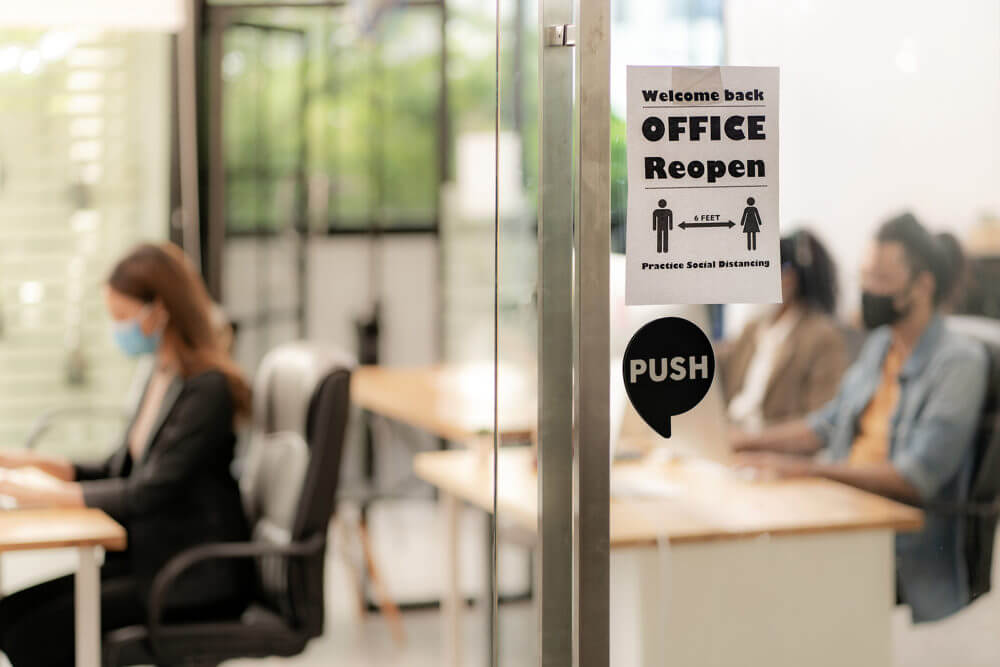
The COVID-19 pandemic has changed how we work, collaborate, and communicate. Now, as businesses begin to reopen and prepare for a post-pandemic future, many organizations are shifting to new work models. Some companies are heading back to the office full time and adjusting to changing requirements state by state. Other companies are testing out hybrid work models that combine remote work and in-office collaboration.
What does re-opening mean for you and your employees? We’re exploring five changes that will impact the workplace and how to find success in the new world of work.
As companies move toward re-opening their offices full time, many have implemented a hybrid work model as a way to transition back. Often, this process uses rotating schedules, shifting employees between working from home and working in the office.
Here’s how it generally works: One group of employees will come in on Monday, Wednesday, and Friday, while a second group take Tuesday and Thursday. Days are switched the following week, so the groups alternate between two and three days per week in the office. Those not in the office work from home as they have been throughout the pandemic. Experts suggest using in-office days for meetings and projects that require more collaboration, keeping remote days reserved for work that can be done on an individual level or requires extra concentration.
Hybrid work models like this offer the structure and sociability that people enjoy in the office, while also providing independence and flexibility when working remotely. Shifting schedules also have the added benefit of reducing commuting time for employees, making people less stressed and more productive as they transition back to the office.
Communication was key when employees were working completely remote, but transparent and clear messages are even more crucial in distributed teams and during periods of transition. Let’s say you need to have a project meeting, but some of the team is working remotely that day. While it might seem easy to gather everyone into a conference room and allow remote employees to video call in, this structure can create divisions within the group. Those gathered in-person can easily dominate the conversation or start side conversations that exclude people not present.
Instead, consider having everyone join a virtual meeting from their own workspace or device, even those physically present in the office. This allows team members equal opportunity to share and voice opinions and helps the group stay on track during meetings. You might also need to re-evaluate the platform(s) you use for communication and make sure everyone is using the same tools. What worked well when employees were all remote might not be as efficient in a hybrid or in-person work model.
With many offices and workplaces reopening, it can be tempting to assume that these spaces are safe again. But, unfortunately, COVID hasn’t disappeared and it is still necessary to make changes to the workplace to ensure continued safety. This includes keeping people physically distant from each other as much as possible, cleaning and sanitizing spaces regularly, and following CDC and state guidelines. Office safety and changes might also vary from location to location if your company operates in multiple places. IDR, for example, has offices in different states so implementing safety guidelines looks a little different at each of our six branches.
Long term, many experts expect offices to operate differently due to the impact of COVID-19. Where cubicles previously dominated workspaces, we are likely to see more shared, open spaces in the future. And for those companies using hybrid work models or staying fully remote, some offices may look to reduce costs and downsize their workspace permanently.
Companies were forced to adapt quickly when the pandemic started. Many had to update their technology and implement new digital systems and solutions so that work could continue from home. Now, hybrid and in-person work models will require another digital shift. Up until now, organizations were focused on making remote work accessible and secure. However, what worked best for remote work isn’t necessarily what’s best in the workplace.
So, how can businesses accommodate both employees working in the office and those at home? Some companies are looking to smart workspaces, digital information systems, and new cybersecurity tools that allow greater flexibility and improve work, no matter where employees are working from. Others remain focused primarily on security, especially as more systems shift to the cloud. Ultimately, whatever organizations decide, tech solutions need to be reliable, easy to use, agile, and scalable for employees to find success in the new world of work.
Keeping your employees engaged when everyone is working remotely is a challenge. Over the long term, remote work can leave people feeling disconnected from their job, their colleagues, and their purpose. And while hybrid and in-person work can help alleviate some of these issues, they don’t disappear. That’s why it is so important to find ways to engage employees, whether they are at home or in the office.
One way to do this is to create a connected culture, blending virtual meetings with work/life balance and opportunities for co-workers to interact. Strengthening your workplace culture and emphasizing connection helps employees stay engaged, no matter where they’re working, and creates workplaces that support employees, now and in the future.
Related Articles
IDR, Inc. Named One of 2021’s Best Staffing Firms to Work For by Staffing Industry Analysts
The Future of Telemedicine and Healthcare Trends in 2021